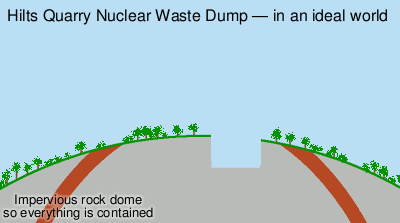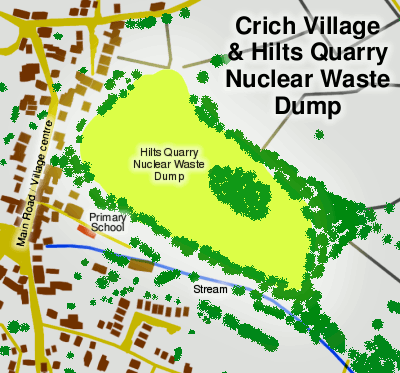|
Let the Devil Wear Black | James F Linden. The true story of the Courtaulds Cancer-Gas Scandal. |
Resources - Hilts Location
Choosing a location for a nuclear waste dump.
Chapter 23
So, how do you choose a location for a nuclear waste dump?
First of all, you need to understand what a nuclear waste dump is. We are all familiar with the concept of ‘dumping’ something — you just get rid of it and, as far as the nuclear process is concerned, that is what is happening. However, it is not as simple as that.
It is perhaps more useful to look at the problem from the other side. When we talk about ‘dumping’, we are talking about removing something from a place but when you take something from one place, you have to move it to another place. Looking at a nuclear dump from this point of view makes us realise that rather than simply a ‘nuclear waste dump’, we have a ‘nuclear storage facility’ — a term that puts a completely different perspective on it.
Now we have worked out that we are actually storing nuclear waste, what do we need to have?
Nuclear waste is potentially dangerous — like many chemicals, nuclear chemicals can be toxic, but also, they are radioactive. It is the radioactivity that we need to think about.
Radioactive compounds are all around us. In fact, potassium — the chemical that is found in abundance in potatoes, tomatoes and bananas; and is a necessary component of our body chemistry — is radioactive. There is around 160g of potassium in our bodies which, when multiplied by the abundance of potassium–40, the radioactive isotope of potassium, means that there is around 18.7mg of potassium–40 which gives a count rate of around a 4,400 decays per second or 4,400 becquerels (Bq) continuously, for your whole life, and after that as well.
Bananas were mentioned above and just to put that into perspective, there is such a thing as a ‘Banana Equivalent Dose’ (BED) — the amount of radioactivity from eating one banana — which gives around 15 Bq.
As we have evolved, we have just got used to this level of radioactivity and our bodies have ways of repairing the damage caused by it. However, there is a difference of scale between the BED and a nuclear waste dump.
Radioactivity can persist for hundreds of thousands of years and the chemicals can dissolve in water just like any others — some are more soluble than others. So, our dump needs to be somewhere where water cannot escape from.
It also needs to be away from people, and preferably, also away from animals in general but also animals that people are likely to eat. So, somewhere that is:
- located remotely;
- deep underground;
- geologically stable; and,
- away from any moving water.
We also need to keep it secret.
How about a disused limestone quarry in Derbyshire, surrounded on three sides by a village, next to a primary school, in an area that, although it has an impervious dome, it is perforated in several known places as well as at least three unknown places so that local water can drain out of it, into local streams that then run through other villages, where any dissolved radioactive chemicals can splash onto vegetation and soil, dry out and then blow away freely in the summer breeze for people to breathe in.
In order to keep it secure, the gate on the perimeter fence can be secured by a combination lock. Combination locks are fine for stopping opportunistic entry in an area where there are plenty of onlookers and time is limited but if it is secluded — such as if it was a secret location — and there are people that have plenty of time on their hands — such as local school children who are out playing — they are useless.
What were they thinking?
I had no doubt that as time went on, other issues would float to the surface as the company’s tangled web caught along the bottom of the river — all I had to do was sit on the side and wait.
Copyright © 1994-2023 James F Linden. All Rights Reserved.




